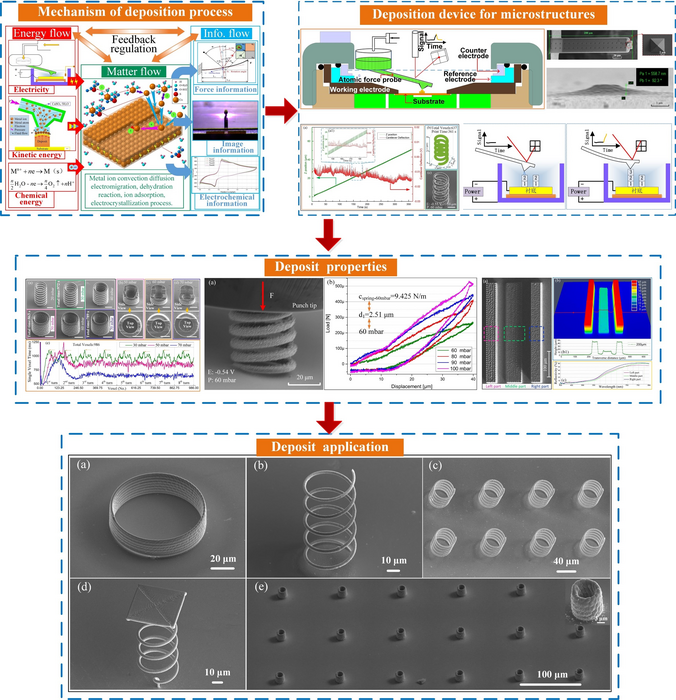Reviewed by Alex SmithJul 28 2022
Acquiring exact perception and successful identification requires high-quality data transfer, high-precision information sensing, and high-sensitivity signal detection. Extreme environment sensor manufacturing technologies, terahertz transmission T/R components, and high-performance processors have all emerged as important frontier research hotspots.
 By combining atomic force probes with microfluidics, this research proposes a method of “localized electrodeposition micro-additive manufacturing of atomic force servo pulse microjets”. Following with the research idea of “single voxel deposition-multiple voxels bonding-small structure forming” and the manufacturing essential law of the interaction of “Material-Energy-Information”, we integrate four key technologies to develop a maskless, supportless, long cantilever inert metal electrochemical additive manufacturing (LECD-μAM) method including pulsed microjet electrolyte pressurization injection (Material supply), focused electric-induced localized electrochemical deposition (Energy replenishment), atomic force servo closed-loop control (Information feedback) and digital model conversion accuracy maintenance. Besides, the printing state of the micro-helical springs can be assessed by detecting the Z-axis displacement and the deflection of the atomic force probe (AFP) cantilever at the same time. Results show that it took 361 s to print a helical spring with a wire length of 320.11 μm at a deposition rate of 0.887 μm/s which can be changed on-the-fly by simply tuning the extrusion pressure and the applied voltage. Moreover, the in-situ nanoindenter is used to measure the compressive mechanical properties of the helical spring. The shear modulus of the helical spring material was about 60.8 Gpa, much higher than that of bulk copper (~44.2 Gpa). These results have discovered a new way of fabricating the terahertz transmitter components and micro-helical antennas by LECD-μAM technology. Image Credit: Wanfei Ren, Jinkai Xu, Zhongxu Lian, Xiaoqing Sun, Zhenming Xu, Huadong Yu
By combining atomic force probes with microfluidics, this research proposes a method of “localized electrodeposition micro-additive manufacturing of atomic force servo pulse microjets”. Following with the research idea of “single voxel deposition-multiple voxels bonding-small structure forming” and the manufacturing essential law of the interaction of “Material-Energy-Information”, we integrate four key technologies to develop a maskless, supportless, long cantilever inert metal electrochemical additive manufacturing (LECD-μAM) method including pulsed microjet electrolyte pressurization injection (Material supply), focused electric-induced localized electrochemical deposition (Energy replenishment), atomic force servo closed-loop control (Information feedback) and digital model conversion accuracy maintenance. Besides, the printing state of the micro-helical springs can be assessed by detecting the Z-axis displacement and the deflection of the atomic force probe (AFP) cantilever at the same time. Results show that it took 361 s to print a helical spring with a wire length of 320.11 μm at a deposition rate of 0.887 μm/s which can be changed on-the-fly by simply tuning the extrusion pressure and the applied voltage. Moreover, the in-situ nanoindenter is used to measure the compressive mechanical properties of the helical spring. The shear modulus of the helical spring material was about 60.8 Gpa, much higher than that of bulk copper (~44.2 Gpa). These results have discovered a new way of fabricating the terahertz transmitter components and micro-helical antennas by LECD-μAM technology. Image Credit: Wanfei Ren, Jinkai Xu, Zhongxu Lian, Xiaoqing Sun, Zhenming Xu, Huadong Yu
Its successful implementation is highly dependent on the complex microstructure of the core functional devices’ ultra-precision micro-nano manufacturing level. Pure copper metal is a perfect carrier for information-enabled core functional devices due to its strong ductility, ultra-high electrical conductivity, and minimal signal loss characteristics.
As a result, it has drawn a lot of attention from the micro-nano manufacturing community.
The Changchun University of Science and Technology’s Prof. Huadong Yu, Researcher Jinkai Xu, Wanfei Ren, Zhongxu Lian, Xiaoqing Sun, and Zhenming Xu recently published in IJEM.
The authors optimized the produced microstructure for performance testing and systematically introduced the localized progress of the micro-additive material production process of the micro pure copper structure.
Professor Huadong Yu of Jilin University, who is also the Chief Technology Officer of the Key Laboratory of Cross-scale Micro-Nano Manufacturing of the Ministry of Education, and Professor Jinkai Xu of CUST and the Director of the National and Local Joint Engineering Laboratory of Precision Manufacturing and Detecting Technology/Key Laboratory of Cross-scale Micro-Nano Manufacturing of the Ministry of Education, and the leader of the micro-nano manufacturing discipline of CUST, along with Wanfei Ren, a lecturer at CUST, have developed some techniques for micronano manufacturing.
These specifics are as follows:
“Although the technique demonstrates the fabrication of pure copper microstructures, the technology has applications as early as 2018. What are the main contributions of this paper?”
“The authors in this paper proposed a mathematical model of the synergy of pulsed micro-jet, focusing electric induction and atomic force servo. Although preliminary, this model establishes the initial model of electrochemical deposition, material transport and force information feedback.”
“The article mainly introduces the various characteristics of the deposited pure copper microstructure. Can you briefly introduce it?”
“The manufacture of pure copper microstructure was realized, and the deposition rate was 0.887 μm/s. Shear modulus of pure copper microspring was tested and reached 60.8GPa.”
“What is the role of the device during the experiment?”
“The device used in the experiment are from Exaddon AG, Switzerland. The function of the device is to monitor the state of the deposition process during the experiment. Thanks to the device, the Z-direction position of the atomic force probe and the bending state of the cantilever can be detected online at the same time.”
Journal Reference:
Ren, W., et al. (2022) Localized electrodeposition micro additive manufacturing of pure copper microstructures. International Journal of Extreme Manufacturing. doi:10.1088/2631-7990/ac3963.